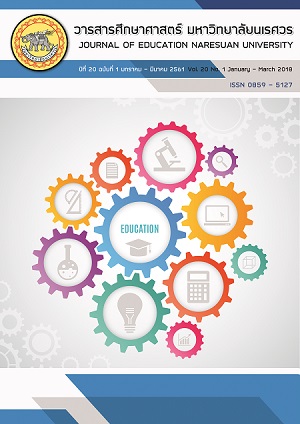การสังเคราะห์งานวิจัยภาวะผู้นำในสถานศึกษาไทย: การวิเคราะหอภิมาน; RESEARCH SYNTHESIS IN THAI EDUCATIONAL LEADERSHIP: A META-ANALYSIS
Main Article Content
Abstract
การวิจัยครั้งนี้มีวัตถุประสงค์เพื่อสังเคราะห์งานวิจัยภาวะผู้นำในสถานศึกษาด้วยวิธีการวิเคราะห์ อภิมาน 1) เพื่อศึกษาขนาดอิทธิพลในแต่ละกลุ่มทฤษฎีของภาวะผู้นำจากงานวิจัยที่ศึกษาภาวะผู้นำในสถานศึกษาในประเทศไทย 2) เพื่อศึกษาขนาดอิทธิพลในแต่ละองค์ประกอบของกลุ่มทฤษฎีจากงานวิจัยที่ศึกษาภาวะผู้นำในสถานศึกษาในประเทศไทย 3) เพื่อศึกษาขนาดอิทธิพลในแต่ละองค์ประกอบของงานวิจัยที่ศึกษาภาวะผู้นำการเปลี่ยนแปลงในสถานศึกษาในประเทศไทย ตัวอย่างการวิจัยครั้งนี้คือรายงานการวิจัยจำนวน 75 เล่ม ที่เผยแพร่ตั้งแต่แต่ปี 2542 ถึง 2556 ด้วยการค้นหาจากฐานข้อมูลวิทยานิพนธ์ เครื่องมือที่ใช้คือแบบบันทึกผลการวิจัยที่ผู้วิจัยออกแบบเพื่อบันทึกค่าสัมประสิทธิ์สหสัมพันธ์จากงานวิจัยที่นำมาศึกษา ข้อมูลถูกวิเคราะห์โดยเทคนิคการวิเคราะห์อภิมานสหสัมพันธ์ด้วยการวิเคราะห์ค่าอิทธิพลแบบสุ่ม ผลการศึกษา
1) กลุ่มทฤษฎีภาวะผู้นำ ด้านพฤติกรรมของผู้นำ ด้านลักษณะนิสัยผู้นำ ด้านผู้นำตามสถานการณ์ ด้านภูมิหลังของผู้นำ พบว่า มีค่าขนาดอิทธิพลต่อการเป็นผู้นำ 0.686, 0.677, 0.614 และ 0.226 ตามลำดับ 2) การวิเคราะห์แต่ละกลุ่มทฤษฎี ด้านพฤติกรรมของผู้นำ พบค่าขนาดอิทธิพล 14 ด้าน ค่าที่สูงที่สุดคือการบารมี 0.726 รองลงมา คือ ผู้นำที่มุ่งงาน 0.714 ด้านลักษณะนิสัยของผู้นำ พบค่าขนาดอิทธิพล 14 ด้าน ค่าที่สูงที่สุดคือการสนับสนุนทีม 0.822 รองลงมา คือ คุณธรรมจริยธรรมของผู้นำ 0.808 ด้านผู้นำตามสถานกรณ์พบค่าขนาดอิทธิพล 10 ด้าน ค่าที่สูงที่สุด คือ การมีข้อมูลสนับสนุน 0.784 รองลงมา คือ ทีมงานที่มีความพร้อม 0.741 และด้านภูมิหลังผู้นำ พบค่าขนาดอิทธิพล 7 ด้าน ค่าที่สูงที่สุด คือ ทัศนคติต่อการเป็นผู้นำ 0.696 รองลงมา คือ เศรษฐานะของผู้นำ 0.482 และ 3) การวิเคราะห์ขนาดอิทธิพลในแต่ละองค์ประกอบของภาวะผู้นำการเปลี่ยนแปลง การกระตุ้นการใช้ปัญญา การสร้างแรงบันดาลใจ การคำนึงรายบุคคล และการมีบารมี มีค่าขนาดอิทธิพลที่ 0.817, 0.804, 0.770 และ 0.741 ตามลำดับ ความรู้ที่ได้จากการวิจัยครั้งนี้ พบว่า พฤติกรรม ลักษณะนิสัย และสถานการณ์ มีความสัมพันธ์กับภาวะผู้นำในระดับสูง พฤติกรรมที่ผู้นำควรเลือกใช้ คือ การสร้างบารมีและเป็นผู้นำที่มุ่งงาน ลักษณะนิสัยที่ผู้นำควรนำมาใช้ คือ การส่งเสริมให้ผู้ตามได้มีส่วนร่วมมากขึ้นและผู้นำควรมีคุณธรรมจริยธรรม และในด้านผู้นำตามสถานการ์ผู้นำต้องมีข้อมูลเพื่อการบริหารจัดการมากเพียงพอและผู้ร่วมงานต้องมีความพร้อมในการทำงานสูง การใช้ภาวะผู้นำการเปลี่ยนแปลง ผู้นำควรมุ่งใช้วิธีการกระตุ้นการใช้ปัญญา และการสร้างแรงบันดาลใจ ผู้ร่วมงานจึงจะสามารถรับรู้ภาวะผู้นำและไปสู่การเปลี่ยนแปลงได้ดีกว่า
RESEARCH SYNTHESIS IN THAI EDUCATIONAL LEADERSHIP: A META-ANALYSIS
The purposes of this research were to synthesize research paper in educational leadership in Thailand using meta-analysis 1) to analyze effect size of educational leadership research from each theory group, 2) to analyze effect size of subscales of each educational leadership theory group, and 3) to analyze effect size of subscales of transformational leadership. Samples were selected from 75 educational leadership research paper published between B.E 2542 – 2556 by searching from online research database. Research tool used in this research was self-designed result record form to record correlations found in research paper. Data were analyzed by correlation meta-analysis technique with random effect analysis. Results were in three folds
1) the group of leadership theory comprises of behavior, traits, contingency and background. The effect sizes were 0.686, 0.677, 0.614 and 0.226 accordingly. 2) Each of leadership theory group, for leadership behaviors, there were 14 effect sizes, the highest were charismatic and task-oriented leader, showed 0.729 and 0.714. For leadership traits, there were 14 effect sizes. The highest were team support and moral of leader, showed 0.822 and 0.808 effect size accordingly. For contingency, there were 10 effect sizes. The highest were having enough Information and mature team, showed 0.784 and 0.741. And, for leader’s backgrounds, there were
7 effect sizes. The highest were leader’s attitude and economy status, showed 0.696 and 0.482. 3) For effect size of each subscales of transformational leadership, they showed intellectual stimulation, inspirational motivation, individualized consideration and idealized influence effect sizes as 0.817, 0.804, 0.770 and 0.714 accordingly. The findings from this research were that the highly noticeable characteristics of educational leadership were behavior and traits rather than contingency or background. The two important behaviors were charismatic and being task-oriented leader to gain recognition in leadership. Hence, the leaders should promote moral in work environment and being intellectual stimulation and individual inspiration to team which will raise perfect leadership role and lead to follower’s transformation.
Article Details
The owner of the article does not copy or violate any of its copyright. If any copyright infringement occurs or prosecution, in any case, the Editorial Board is not involved in all the rights to the owner of the article to be performed.
References
Antonakis, J., & House. (2013). The Full-Range Leadership Theory: The Way Forward. Transformational and Charismatic Leadership: The Road Ahead 10th Anniversary Edition. Monographs in Leadership and Management, 5,
3-33.
Bass, B. M., & Avolio, B. J. (1990). Transformational leadership development: manual for the multifactor leadership questionnaire. Palo Alto, Calif.: Consulting Psychologists Press.
DerSimonian, R., & Laird, N. (1986). Meta-analysis in clinical trials. Controlled clinical trials, 7(3), 177-188.
Fisher, R. A. (1915). Frequency distribution of the values of the correlation coefficient in samples from an indefinitely large population. Biometrika, 10(4), 507-521.
Glass, G. V., MacGaw, B., & Smith, M. L. (1984). Meta-analysis in social research. Beverly Hills, CA.: Sage.
Higgins, J., & Thompson, S.G. (2002). Quantifying heterogeneity in a meta-analysis. Statistics in Medicine, 21, 1539– 1558.
Higgins, J., Thompson, S. G., Deeks, J. J., & Altman, D. G. (2003). Measuring inconsistency in meta-analyses. BMJ, 327, 557– 560.
Hunter, J. E., & Schmidt, F. L. (2004). Methods of Meta-analysis: Correcting Error and Bias in Research Findings (2nd ed.). Newbury Park, CA: Sage Publications.
Office of the Higher Education Commission. (2015). List of educational institution. Retrieved February 3, 2015, from www.mua.go.th/muaold/know_ohec/university_mua.xls (in Thai)
Phusilp, P., & Tangutairuang, T. (2017). Academic Leadership Model of Primary Demonstration School Administrators under Rajabhat Universities. SDU Research Journal of Humanities and Social Sciences, 13(1), 129-142.
Tangutairuang, T. (2014). A Causal Model of the Effectiveness of Small-Sized Primary Schools under the Office of the Basic Education Commission in the Central Region of Thailand. SDU Research Journal of Humanities and Social Sciences, 10(3), 95-112. (in Thai)
Tangutairuang, T. (2016). Meta-Analytic Structural Equation Modeling Technique. Suratthani Rajabhat Journal, 3(2), 57-79. (in Thai)
Tshering, K., & Sawangmek, T. (2016). The Relationship between Principal’S Instructional Leadership and School Effectiveness in The Urban Schools of Bhutan. Journal of Education Naresuan University, 18(3), 226-236. (in Thai)
Yukl, G. A. (2006). Leadership in organizations. Pearson Education India.


